|
Sunday:
July 20, 2003 | |
0309 GMT |
 |
Cosmic mirage: Discovery of quasar with Einstein ring
Using the ESO telescope at La Silla, Chile, an international team of astronomers has discovered a complex cosmic mirage in the southern constellation Crater. This "gravitational lens" system consists of at least four images of the same quasar as well as a ring-shaped image of the galaxy in which the quasar reside - known as an "Einstein ring".
 FULL STORY FULL STORY
 |  |

|
 |
|
Saturday:
July 19, 2003 | |
0312 GMT |
 |
Detailed maps reveal early Universe galaxy distribution
Peering back in time more than 7 billion years, a team of astronomers using a powerful new spectrograph at the Keck Observatory in Hawaii has obtained the first maps showing the distribution of galaxies in the early universe. The maps show the clustering of galaxies into a variety of large-scale structures, including long filaments, empty voids, and dense groups and clusters.
 FULL STORY FULL STORY
 |  |

|
 |
Mars-bound Opportunity rover adjusts trajectory
NASA's Opportunity spacecraft made its first trajectory correction maneuver Friday, a scheduled operation to fine-tune its Mars-bound flight path. For the trajectory adjustment, flight team members commanded Opportunity to perform a prescribed sequence of thruster firings.
 FULL STORY FULL STORY
 |  |

|
 |
|
Friday:
July 18, 2003 | |
0721 GMT |
 |
Enhanced version of Atlas 5 rocket debuts successfully
The largest and most powerful Atlas rocket in history rushed off its Cape Canaveral pad on a river of golden flame Thursday evening to expand Lockheed Martin's launcher family.
 FULL STORY FULL STORY
 MISSION STATUS CENTER MISSION STATUS CENTER
 |  |

|
 |

Video coverage for subscribers only:
 VIDEO: 5 1/2-MINUTE CLIP OF ATLAS 5 LAUNCHING RAINBOW 1 QT VIDEO: 5 1/2-MINUTE CLIP OF ATLAS 5 LAUNCHING RAINBOW 1 QT
 VIDEO: LAUNCH REPLAY FROM CAMERA ON VIF ASSEMBLY BUILDING QT VIDEO: LAUNCH REPLAY FROM CAMERA ON VIF ASSEMBLY BUILDING QT
 VIDEO: CLOSE-UP VIEW OF SOLID ROCKET BOOSTER AT IGNITION QT VIDEO: CLOSE-UP VIEW OF SOLID ROCKET BOOSTER AT IGNITION QT
 VIDEO: REPLAY FROM ATLAS SPACEFLIGHT OPERATIONS CENTER QT VIDEO: REPLAY FROM ATLAS SPACEFLIGHT OPERATIONS CENTER QT

 VIDEO: ATLAS 5 ROLLS OUT OF ASSEMBLY BUILDING THURSDAY QT VIDEO: ATLAS 5 ROLLS OUT OF ASSEMBLY BUILDING THURSDAY QT
 VIDEO: THE ROCKET ARRIVES ON COMPLEX 41 LAUNCH PAD QT VIDEO: THE ROCKET ARRIVES ON COMPLEX 41 LAUNCH PAD QT
 VIDEO: WATCH ENTIRE 41-MINUTE PRE-LAUNCH NEWS CONFERENCE QT VIDEO: WATCH ENTIRE 41-MINUTE PRE-LAUNCH NEWS CONFERENCE QT
 SUBSCRIBE NOW SUBSCRIBE NOW

|
Hubble tracks down a galaxy cluster's dark matter
Using the powerful trick of gravitational lensing, a European and American team of astronomers have constructed an extensive "mass map" of one of the most massive structures in our Universe. They believe that it will lead to a better understanding of how such systems assembled and the key role of dark matter.
 FULL STORY FULL STORY
 |  |
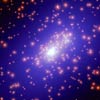
|
 |
Orphaned star clusters roam the Universe
US and UK astronomers have discovered a population of previously unknown star clusters in what was thought to be the empty space between galaxies.
 FULL STORY FULL STORY
 |  |

|
 |
|
Thursday:
July 17, 2003 | |
0350 GMT |
 |
New version of Atlas 5 rocket to launch Thursday
The largest and most capable Atlas rocket in history will take flight Thursday evening from Cape Canaveral as Lockheed Martin's launcher fleet evolves to carry larger and heavier cargos into space.
 FULL STORY FULL STORY
 MISSION STATUS CENTER -- updates! MISSION STATUS CENTER -- updates!
 |  |

|
 |
Movies from Atlas 5 tour
Lockheed Martin hosted an extraordinary tour for media representatives earlier this week, giving the reporters an upclose look at the fully assembled Atlas 5 rocket inside the Vertical Integration Facility at Cape Canaveral's Complex 41. The rocket's new nose cone and solid rocket boosters were of particular interest since they will be flying for the first time on this launch.
 |  |

|
 |

Video coverage for subscribers only:
 VIDEO: VIEWS OF THE AEROJET-MADE SOLID ROCKET BOOSTERS QT VIDEO: VIEWS OF THE AEROJET-MADE SOLID ROCKET BOOSTERS QT
 VIDEO: FOOTAGE OF THE CONTRAVES-BUILT PAYLOAD FAIRING QT VIDEO: FOOTAGE OF THE CONTRAVES-BUILT PAYLOAD FAIRING QT
 VIDEO: TECHNICIAN CLIMBS INTO THE FAIRING FOR WORK QT VIDEO: TECHNICIAN CLIMBS INTO THE FAIRING FOR WORK QT
 VIDEO: ATLAS 5 AND SPACE SHUTTLE PADS FROM ATOP THE VIF QT VIDEO: ATLAS 5 AND SPACE SHUTTLE PADS FROM ATOP THE VIF QT
 SUBSCRIBE NOW SUBSCRIBE NOW

|
Smoking supernovae solve ten billion year old mystery
A team of UK astronomers have announced the discovery that some supernovae have bad habits -- they belch out huge quantities of 'smoke' known as cosmic dust. This solves a mystery more than 10 billion years in the making. The new observations answer long-standing questions about the origin of the first solid particles ever to form in the Universe.
 FULL STORY FULL STORY
 |  |

|
 |
NASA seeks to discover if comets seeded life
NASA's Goddard Space Flight Center will lead the effort to discover if comets supplied the raw material for the origin of life on Earth, and if they could do so for alien worlds, as part of its participation in NASA Astrobiology Institute research.
 FULL STORY FULL STORY
 |  |

|
 |
|
Wednesday:
July 16, 2003 | |
0631 GMT |
 |
Crew module likely survived shuttle breakup
The astronauts aboard the shuttle Columbia, strapped into a reinforced module built to withstand extreme forces, likely survived a minute or more beyond the commander's final transmission, sources say. Engineers believe the crew died when the module, buffeted by increasingly extreme aerodynamic forces, finally broke open as it plunged steeply into the thickening atmosphere above Texas.
 FULL STORY FULL STORY
 |  |
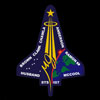
|
 |
New version of Atlas 5 rocket to launch Thursday
The largest and most capable Atlas rocket in history will take flight Thursday evening from Cape Canaveral as Lockheed Martin's launcher fleet evolves to carry larger and heavier cargos into space.
 FULL STORY FULL STORY
 MISSION STATUS CENTER MISSION STATUS CENTER
 |  |

|
 |
Atlas 5 carrying three onboard video cameras
Three video cameras are mounted aboard the Atlas 5 rocket to give engineers live views of critical events during Thursday's launch sequence.
 FULL STORY FULL STORY
 |  |
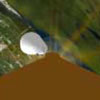
|
 |
Link between black holes, galaxies discovered nearby
By studying more than 120,000 nearby galaxies observed as part of the Sloan Digital Sky Survey, a team of astronomers from Germany and the United States has been able to show that the growth of supermassive black holes is closely linked with the birth of new stars in their host galaxies.
 FULL STORY FULL STORY
 |  |

|
 |
Boeing, Loral report commercial space setbacks
The commercial space industry was hit with a double dose of bad news on Tuesday when satellite operator Loral announced it was filing for bankruptcy protection and selling six of its satellites, while Boeing announced it would take a billion-dollar charge against its launch and satellite businesses while suspending commercial sales of its Delta 4 rocket.
 FULL STORY FULL STORY
 |  |

|
 |
Boeing pulls Delta 4 from commercial satellite market
The Boeing Company announced Tuesday that as a result of continued weakness in the commercial space launch market, higher mission and launch costs on its Delta 4 program, and cost growth in its satellite businesses, the company will recognize pre-tax charges of approximately $1.1 billion, or $0.87 per share, when it announces second quarter results on July 23.
 FULL STORY FULL STORY
 |  |

|
 |
|
Tuesday:
July 15, 2003 | |
0500 GMT |
 |
Satellites see lightning strikes in ozone's origins
During summertime ozone near the Earth's surface forms in most major U.S. cities when sunlight and heat mix with car exhaust and other pollution, causing health officials to issue "ozone alerts." But in other parts of the world, this low level ozone appears to originate naturally in ways that have left scientists puzzled. Now, NASA-funded scientists using four satellites can tell where low level ozone pollution comes from and whether it was manmade or natural.
 FULL STORY FULL STORY
 |  |

|
 |
Digging high and low for 'dirt' on soil moisture
A water-sensing satellite orbits high above Earth. Airplanes packed with research instruments, circle 25,000 feet above three U.S. states and Brazil. Scientists, college students and other volunteers troop into the countryside, armed with sensors and notepads. It's all about "getting the dirt." In this case, collecting detailed information about the soil.
 FULL STORY FULL STORY
 |  |

|
 |
Weather odds look good for Thursday's Atlas 5 liftoff
The weather forecast for Thursday's launch of Lockheed Martin's Atlas 5 rocket carrying the Rainbow 1 direct-to-home TV broadcasting satellite from Cape Canaveral is generally favorable, Launch Weather Officer Jim Sardonia reported Monday.
 MISSION STATUS CENTER MISSION STATUS CENTER
 EARLIER STORY ABOUT MISSION EARLIER STORY ABOUT MISSION
 |  |
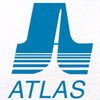
|
 |
|
Monday:
July 14, 2003 | |
0325 GMT |
 |
Fresh, rayed impact crater seen on Mars
This Mars Global Surveyor image shows a fresh, young meteor impact crater on the martian surface. It is less than 400 yards across. While there is no way to know the exact age of this or any other martian surface feature, the rays are very well preserved.
 FULL STORY FULL STORY
 |  |

|
 |
U.S. Air Force studies solar phenomenon
The Air Force Research Laboratory experiment to study solar activity from Earth orbit, the Solar Mass Ejection Imager, launched in January aboard the Coriolis spacecraft, has accomplished a major milestone -- observing its first Earth-directed ("halo") coronal mass ejection.
 FULL STORY FULL STORY
 |  |
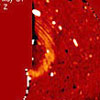
|
 |

